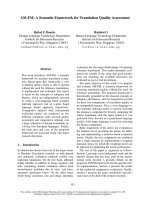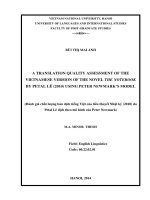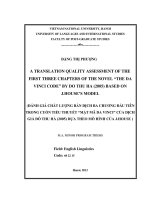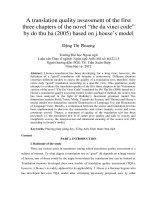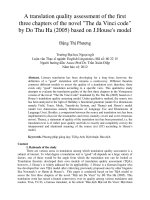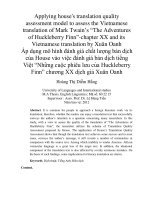Application of house’s model for translation quality assessment in assessing the english version of the vietnam’s law on investment no. 59/2005/qh11
Bạn đang xem bản rút gọn của tài liệu. Xem và tải ngay bản đầy đủ của tài liệu tại đây (413.63 KB, 85 trang )
VIETNAM NATIONAL UNIVERSITY, HANOI
COLLEGE OF FOREIGN LANGUAGES
DEPARTMENT OF GRADUATE STUDIES
LƯƠNG TỐ LAN
APPLICATION OF HOUSE’S MODEL FOR
TRANSLATION QUALITY ASSESSMENT IN
ASSESSING THE ENGLISH VERSION OF THE
VIETNAM’S LAW ON INVESTMENT
NO. 59/2005/QH11
ÁP DỤNG MÔ HÌNH ĐÁNH GIÁ CHẤT LƯỢNG
BẢN DỊCH CỦA HOUSE VÀO VIỆC ĐÁNH GIÁ
BẢN DỊCH TIẾNG ANH
LUẬT ĐẦU TƯ SỐ 59/2005/QH11
M.A. Thesis
Combined Programme Thesis
English Linguistics
60 22 15
HA NOI - 2007
VIETNAM NATIONAL UNIVERSITY, HANOI
COLLEGE OF FOREIGN LANGUAGES
DEPARTMENT OF GRADUATE STUDIES
LƯƠNG TỐ LAN
APPLICATION OF HOUSE’S MODEL FOR
TRANSLATION QUALITY ASSESSMENT IN
ASSESSING THE ENGLISH VERSION OF THE
VIETNAM’S LAW ON INVESTMENT
NO. 59/2005/QH11
ÁP DỤNG MÔ HÌNH ĐÁNH GIÁ CHẤT LƯỢNG
BẢN DỊCH CỦA HOUSE VÀO VIỆC ĐÁNH GIÁ
BẢN DỊCH TIẾNG ANH
LUẬT ĐẦU TƯ SỐ 59/2005/QH11
M.A. Thesis
Combined Programme Thesis
Major: English Linguistics
Code: 60 22 15
Supervisor: Asso. Prof. Dr. Lê Hùng Tiến
HA NOI - 2007
STATEMENT OF AUTHORSHIP
This work contains no material which has been accepted for the award of any other
degree in any university or other tertiary institution and, to the best of my knowledge
and belief, contains no material previously published or written by other persons,
except where due to references has been made in the text.
ACKNOWLEDGEMENT
First of all, I would like to send my deepest gratitude to my supervisor, Asso. Ph.D.
Lê Hùng Tiến, who guided me throughout the accomplishment of this research. If it
had not been for his kind guidance, insightful comments and valuable support, my
thesis would not have been completed.
I also owe my gratitude to my family, who have always been very supportive with my
study. My parents always encourage me in difficult times. And my mother,
especially, often helps me to do housework so that I can have more time to work on
my papers.
Personally, I highly appreciate all the assistance. I am greatly interested in this study
as it is of great help for myself. However, I am responsible for any remaining
mistakes and short comings that are found in this work.
iv
ABSTRACT
In today’s world where no nation can ignore the economic integration trend,
the demand for easy access to the body of legal documents of a country is greater
than ever before. More and more legal documents are being translated into English,
the international language of communication, for reference purposes. This calls for
studies into the field of legal translation to come up with methods and strategies of
translation, as well as assessment and evaluation of translations.
This study aims at revealing the most basic features of Vietnamese and
English legal language, and basic concepts of translation theory in general, legal
translation in particular. Then it will test the appropriateness of House’s model for
translation quality assessment in assessing English translations of Vietnamese legal
documents. This is done through the application of the model in assessing the English
version of the Law on Investment 2005 of Vietnam and conclusions based on the
findings. Finally, implications for translating Vietnamese legal documents into
English will be proposed.
v
TABLE OF CONTENTS
Page
Statement of authorship i
Acknowledgement ii
Abstract iii
Table of contents iv
List of abbreviations vi
List of diagrams vii
INTRODUCTION 1
1. Rational for the study 1
2. Significance of the study 2
3. Scope and objectives of the study 2
3.1. Scope of the study 2
3.2. Research questions 2
4. Research methods 2
5. Overview of the study 3
CHAPTER 1. REVIEW OF LITERATURE 4
1.1.CHARACTERISTICS OF LEGAL LANGUAGE 4
1.1.1. An overview of legal traditions in the world 4
1.1.2. Vietnamese legal system 6
1.1.3. Vietnamese legal language 7
1.1.3.1. History of Vietnamese legal language 7
1.1.3.2. Linguistic features of Vietnamese legal language 7
1.1.4. English legal language 10
1.1.4.1. History of English legal language 10
1.1.4.2. Linguistic features of English legal language 11
vi
1.2. TRANSLATION THEORY 16
1.2.1. Definition of translation 16
1.2.2. Translation methods and strategies 17
1.2.2.1. Translation methods 18
1.2.2.2. Translation strategies 20
1.2.3. Translation equivalence and assessment 21
1.2.4. Translation of legal documents 24
CHAPTER 2. APPLICATION OF HOUSE’S MODEL
FOR TRANSLATION QUALITY ASSESSMENT 27
2.1. Presentation of the model 27
2.1.1. An overview of the model 27
2.1.2. Operation of the model 28
2.2. Application of the model 31
2.2.1. Analysis of Source Text 32
2.2.2. Statement of function 47
CHAPTER 3. DISCUSSION 49
3.1. Comparison of Target Text and Source Text 49
3.2. Quality of the translation 57
3.3. Implications for translating Vietnamese legal documents into English 59
CONCLUSION 62
REFERENCES 64
Appendix A. Vietnamese version of the selected text I
Appendix B. English version of the selected text V
vii
LIST OF ABBREVIATIONS
SL: Source Language
TL: Target Language
ST: Source Text
TT: Translation Text
viii
LIST OF DIAGRAMS
Global Distribution of Legal Systems Page 5
The schema for analyzing and comparing original and translation texts Page 30
ix
INTRODUCTION
1. Rationale for the study
Globalization and integration is an inevitable trend in today’s world. Any
country that rejects this trend will soon be lagged behind in all major fields of social
life. But communication is successful only when the participants can understand each
other. This cannot be achieved if nations with different languages never try to
understand the language of another. Therefore, the need for translation between
languages is greater than ever before. And because English is an accepted
contemporary international language, more and more documents in other languages
are being translated into it. These are documents of all fields: politics, economics,
culture, etc. But when can a translation be considered ‘good’ still draws much
discussion. Translation theorists have their own founded criteria for translation
quality assessment. Among distinguished scholars of this field is Julian House, a
German linguist, with her model for translation quality assessment.
On its route to international economic integration, Vietnam has to make many
new laws as objectively required. Laws in Vietnamese obviously have legal validity.
But reliable English versions of these laws are desirable to foreign investors before
and on coming to do business in Vietnam. Though these English versions do not have
legal value, they should facilitate the process of understanding and obeying
Vietnam’s laws of foreign enterprises. A good translation of a legal document will
mitigate misinterpretations and misapplications.
Of the most recently enacted laws in Vietnam, the Law on Investment of 2005,
number 59/2005/QH11 is one that has received much attention and discussion. The
Law has been translated into English by several translators. An assessment of the
English version of this law is thus desirable.
1
2. Significance of the study
The results of this study will help test the quality of the English translation of
the Law on Investment 2005 of Vietnam under the model developed by the German
linguist House, and suggest any timely changes should there be to limit avoidable
misunderstandings by foreign investors in interpreting the law.
Besides, the study will also propose some suggestions concerning the
translation of Vietnamese authoritative legal documents into English.
3. Scope and objectives of the study
3.1. Scope of the study
The Law on Investment 2005 consists of eighty-nine articles, divided into ten
chapters. A study of the whole document is therefore an overload for this paper. So
the paper will analyze chapter II only, the title of which is “Bảo đảm đầu tư”. There
are seven articles in this chapter, from Article 6 to Article 12.
3.2. Research questions
The study aims at finding answers to two questions:
1. How good is the translation according to House’s model and what are the
remaining problems of the translation?
2. What are some implications for the translation of Vietnamese legal documents
into English?
4. Research methods
This study aims at assessing the quality of the English translation of the Law
on Investment of Vietnam. Therefore, a set of parameters for assessment is necessary.
Among the various criteria and models for translation quality assessment, House’s
model is chosen in this study because it is deemed to have a comprehensive set of
parameters for assessing functional and pragmatic equivalence of the translation text.
Furthermore, as House argues, the model can be applied with a wide range of texts.
In applying House’s model, a source text is first selected, then analyzed to
draw its textual profile along the eight situational dimensions and a statement of
2
function of the ST will be made. Similarly, a profile of the translation text will be
come up with and compared with the ST’s to find out mismatches before a statement
of quality can be drawn about the TT.
5. Overview of the study
The study contains three chapters:
Chapter 1 – Review of Literature
The first part of this chapter will first introduce the main legal traditions in the
world and then give a brief introduction to the legal system of Vietnam. After that, it
will elaborate linguistic features of Vietnamese and English legal languages.
The second part discusses different aspects of translation: definition, methods
and strategies, and equivalence and assessment. Basic characteristics of legal
translation will also be presented.
Chapter 2 – Application of House’s model for translation quality assessment
In this chapter, House’s model for translation quality assessment will first be
presented and then applied in assessing the English translation of the Law on
Investment 2005 of Vietnam.
Chapter 3 – Discussion of results and implications
Findings about the quality of the translation text which is based on the
application of the model will be discussed and implications for translating
Vietnamese legal documents into English will also be come up with.
3
CHAPTER 1.
REVIEW OF LITERATURE
1.1. CHARACTERISTICS OF LEGAL LANGUAGE
Statutes are generally promulgated by the state to govern people’s behaviors in
all aspects of social life. They create, modify, or terminate the rights and obligations
of individuals and institutions.
Once enacted, a legal document becomes authoritative and no law-maker will
be there to explain the wording and to guide the application of the rules in the law.
Therefore, the rules set out in legal documents have to be clear, precise and
unambiguous, on the one hand, to avoid misinterpretations and misapplications of
them, and inclusive, on the other, to cover all the possible cases that can emerge
within the governing scope of the law. To ensure these dual characteristics of legal
rules, law-makers have to make full use of the written language, may it be English,
French, Vietnamese or any other one. Therefore, the language of this type of
documents is highly specialized.
In this study, the term “legal texts” refers to any document within the field of
law, and “legal documents” to statutes, documents issued by the law-making body of
the country. And “legal language” is restricted to the language of these legal
documents.
1.1.1. An overview of legal traditions in the world
Before the serial collapse of some socialist countries in the world in the early
1990’s, there existed a strong belief among scholars in socialist countries that there
were only two traditions of law, i.e. the socialist and the capitalist ones, with the latter
including Anglo-American as well as Continental (Civil) law systems. Western
scholars, on the contrary, distinguish between two main traditions, i.e. the Anglo-
American and the Continental traditions, with socialist legal systems belonging to the
latter one (Bogdan, 1994:63).
4
Today, it is commonly agreed that there are five groups of legal systems
worldwide distributed as follow:
Global Distribution of Legal Systems
Source: />Of these five traditions, Civil Law and Common Law are predominant and
will be discussed further in details.
Civil Law, also known as Continental Law or Roman Law, originated from
Roman law, more specifically, from the sixth century “Corpus Juris Civilis”, a code
consolidating all of the laws in continental Europe during the reign of Roman
emperor Justinian. In countries that follow the civil law tradition, statutes are the
basis of the legal system. Solutions for each individual case are prescribed in the
provisions of the legal codes, on which sentences have to be based. National legal
systems developed through the process of codification.
Common Law shares roots in Roman law with Civil Law but has a much
different evolution from that of Civil Law. The general principles of Common Law
grow out of the judicial decisions in court cases by individual judges over a long
5
period of time. The main source of law and the basis for rules of conduct are past
cases, not codes or legislation. The common law systems include all present and
former members of the British Empire, as well as the United States of America. But it
should be noted that the present common law of the U.S. differs to a great extent from
the common law of Britain, despite the two countries being significant representatives
of Common Law. Therefore, the language of these two systems poses considerable
differences in terms of technical terminologies.
1.1.2. Vietnamese legal system
As stated above, the legal system of Vietnam, like those of other socialist
countries, is now considered a member of the Civil (or Continental) law tradition. It
takes nationally enacted legal documents as its basis. Vietnamese statutes are enacted
by the National Assembly of Vietnam, the highest organ of State power and the only
organ with legislative power of the Socialist Republic of Vietnam (the 1992
Constitution of Vietnam, amended in 2000).
In a socialist-oriented country like Vietnam, law is an important means of
realizing lines and policies of the Communist Party – the leading party – to ensure the
right path of development of the country, the foundation of which is public
ownership. This explains why the idea of public ownership appears quite frequently
in Vietnamese statutes.
Vietnamese laws have a wide governing scope, from the organization and
operation of the State organs to the rights and obligations of the citizens, as well as
the operation of the different aspects of social life (Nguyen Dang Dung et al., 1995).
The legal system of Vietnam consists of a constitution – the fundamental
statute of the whole system, more than 100 statutes, and thousands of by-law
documents of all kinds (Hệ thống văn bản quy phạm pháp luật, Bộ Tư pháp, 2007).
Since its independence in 1945, there have been five constitutions, with the one being
in effect dated in 1992. And during its economic integration, Vietnam is continuously
perfecting its legal system by amending old laws and enacting new ones.
6
1.1.3. Vietnamese legal language
1.1.3.1. History of Vietnamese legal language
The history of Vietnamese legal language cannot be traced as clearly as its
English counterpart because of its shorter history of development, as well as of the
shorter history of the legal system.
The development history of the Vietnamese language can be summarized as
follows, according to Tran Chi Doi, Nguyen Thien Giap (2005: 15-19) and the
National Center of social sciences and humanity (2002: 13-15):
Vietnamese as a distinct language did not start to develop until the 9
th
century.
From the 9
th
century through the early 14
th
century, Vietnamese was used by ordinary
people as their mother tongue, but Chinese was still used as an administrative tool.
The script of Vietnamese, the Nom, appeared in the period from the early 14
th
to the late 15
th
centuries, during which Vietnamese had not gained its status as an
administrative language. This period also witnessed the development of a class of
Chinese-Vietnamese words.
In 1651, with the Annam-Lustin-Latin dictionary by priest A. de Rhodes,
Vietnamese started to be recorded in Latin, which contributed to its emergence to be a
scholarly language and even at times the state’s administrative language during the
period from the early 16
th
to the early 19
th
centuries.
By the early 20
th
century, Vietnamese had almost completed its development.
And after the August Revolution, it was recognized as the official language of
Vietnam. It is now the language of all socio-economic activities, including politics.
1.1.3.2. Linguistic features of Vietnamese legal language
Before Tien’s doctoral thesis in 1999, which studied linguistic features of
Vietnamese legal language as a separate discourse type, legal documents were only
treated as a sub-type of documents of the administrative style. Some notable works
are those of Dinh Trong Lac and Nguyen Thai Hoa; and Cu Dinh Tu. A study of
these works points out the following linguistic features of the language of Vietnamese
legal documents:
7
1.1.3.2.1. Lexical features
* Words are rhetorical and there is a moderate number of bookish words.
* There is technical vocabulary for both the general legal field and specific
branches of law: chế tài, biện pháp hành chính, năng lực pháp luật, quy phạm pháp
luật, xét xử sơ thẩm, xét xử giám đốc thẩm, etc. (general), bị can, đương sự, thế chấp,
giao kết hợp đồng, thoả thuận hợp đồng, etc. (specific).
* Nouns are used with a high frequency, especially nouns formed from verbs,
making the document highly nominalized.
* There is a high percentage of words with Chinese origin.
* Lexical items are carefully selected. There are no vague or ambiguous words,
no jargons, slangs or colloquial words.
1.1.3.2.2. Syntactic features
* Post-modifications in nominal groups are often extended to a rather abnormal
length: (doanh nghiệp) có vốn đầu tư nước ngoài đã đầu tư trong các lĩnh vực không
thuộc lĩnh vực đầu tư có điều kiện, (đầu tư) thông qua mua, bán cổ phần, cổ phiếu,
trái phiếu và giấy tờ có giá khác của tổ chức, cá nhân (theo quy định của pháp luật),
etc.
* Impersonal constructions
+ Avoidance of first and second personal pronouns
Nhà đầu tư được đầu tư phát triển
+ Passives
+ Nominalizations
Việc ưu đãi đầu tư, (thời hạn) hoạt động, (phù hợp với) quy hoạch sử dụng
đất
* Use of modal verbs to establish rights and obligations
For establishing obliged and forbidden actions, the modal verbs “phải, không được”
are used. For establishing permitted actions, the modal verb “được” is used.
Besides the explicit use of modal verbs, the sense of obligation can also be
expressed implicitly in Vietnamese: có thể (được), (phải) theo
8
* Long complex sentences with co-ordinate structures to classify or to detail the
circumstances of application of the provision.
Điều 87. Xử lý vi phạm
1. …
2. Người lợi dụng chức vụ, quyền hạn cản trở hoạt động đầu tư; có hành vi sách
nhiễu, gây phiền hà đối với nhà đầu tư; không giải quyết kịp thời yêu cầu của nhà
đầu tư theo quy định; không thực thi các công vụ khác do pháp luật quy định thì tuỳ
theo tính chất, mức độ vị phạm mà bị xử lý kỷ luật, xử phạt hành chính hoặc bị truy
cứu trách nhiệm hình sự.
(Law on Investment 2005 of Vietnam)
* A system of enumeration with numbers I, II, III, …, 1, 2, 3, … or letters a, b,
c, … is used to separate the parts of complex structures, making them clear in terms
of meaning.
* Use of syntactic discontinuity.
* Chapters and articles are summarized with a noun phrase: Điều 45. Thủ tục
đăng ký đầu tư đối với dự án đầu tư trong nước, Điều 66. Bảo lãnh của Nhà nước
cho một số công trình xây dựng và dự án quan trọng.
1.1.3.2.3. Textual features
* Repetition of nouns
Điều 36. Ưu đãi về sử dụng đất
1. Thời hạn sử dụng đất của dự án đầu tư không quá năm mươi năm; đối với dự án
đầu tư có vốn đầu tư lớn nhưng thu hồi vốn chậm, dự án đầu tư vào địa bàn có điều
kiện kinh tế - xã hội khó khăn, địa bàn có điều kiện kinh tế - xã hội đặc biệt khó khăn
mà cần thời hạn dài hơn thì thời hạn giao đất, thuê đất không quá bảy mươi năm.
* Use of anaphoric and cataphoric reference
Điều 29. Lĩnh vự đầu tư có điều kiện
1. …
2. Đối với nhà đầu tư nước ngoài, ngoài các lĩnh cự quy định tại khoản 1 Điều này,
…
* Avoidance of pronouns
9
* Cognitive structure of “(Nếu) X (+ X’ + X’’ + …) thì Y (+ Y’ + Y’’ + …)”
In this structure, X and Y are the core, and X’, X’’ … as well as Y’, Y’’ … are
detailing parts.
Điều 36. Ưu đãi về sử dụng đất
1. …
Khi hết thời hạn sử dụng đất, nếu nhà đầu tư chấp hành đúng pháp luật về đất đai
và có nhu cầu tiếp tục sử dụng đất thì sẽ được cơ quan nhà nước có thẩm quyền xem
xét gia hạn sử dụng đất phù hợp với quy hoạch sử dụng đất đã được phê duyệt.
The core of this provision is “( Nếu) nhà đầu tư có nhu cầu tiếp tục sử dụng đất thì
được xem xét gia hạn.”
1.1.4. English legal language
1.1.4.1. History of English legal language
Modern legal English is shaped by the long history of development of
Common Law of Britain. According to Peter Tiersma, the history of English legal
language can be summarized as follows:
The Anglo-Saxons drove away the Celtic language of the original inhabitants
of England and their laws left traces in present legal English. Some Anglo-Saxon
words or legal terms still exist today, such as write, ordeal, witness, deem, oath.
In the late 6
th
century, Christian missionaries came and brought with them
Latin. This language became predominant over English and was the language of
formal written legal documents.
After the Norman conquest in 1066, French became the language of power,
but Latin was still used as a written language of the law until the end of the 13
th
century. And up to today, legal maxims (like per pro – with the authority of, as in
‘the secretary signed per pro the manager’), names of writs and terminology for case
names (versus, ex rel, etc.) are still in Latin. But by the 14
th
century, French had
replaced Latin to be the language of statutes. Some characteristics of this French are
still found in modern legal English: addition of initial e to words; addition of –ee to
10
words to indicate the person who was the recipient or object of an action; adjectives
that follow nouns (as in attorney general, letters testamentary, malice aforethought.
But as the language for legal purposes, Latin and French were only used by
people of the upper class and by legal professionals. So soon after its ascendancy to
be the predominant language of the law, French declined to be a living language and
finally started to be replaced by English in the legal field in the late 15
th
century.
Along with the colonization of the British Empire, English common law and
legal English were transported to many countries in the world, including North
America. Yet, the English legal language of these two systems are not identical.
There are different concepts as well as different words for similar concepts. For
example, there is no distinction between solicitor and barrister in the United States as
in Britain; and American corporate law is equivalent to British company law.
1.1.4.2 Linguistic features of English legal language
Since the 1980s, there has been a growing number of studies into the field of
English legal language. Some notable studies are those of Bhatia, Melinkoff, Maley
and Tiersma. In this section, their findings will be summarized in terms of lexical,
syntactic and textual features of English legal language.
1.1.4.2.1. Lexical features
Perhaps the lexicology of legal English is the most distinctive feature making
it highly specialized.
a) Technical vocabulary
* Legal English makes use of a great deal of terminology that is generally
unfamiliar to the lay audience. These are words and phrases like restrictive covenant,
restraint of trade, promissory estoppel, etc.
- restrictive covenant: clause in a contract which prevents someone from
doing something
- restraint of trade: (i) situation where a worker is not allowed to move to
another job in the same trade, (ii) attempt by companies to fix prices or create
monopolies or reduce competition, which could affect free trade
11
- promissory estoppel: promise made by one person to another, so that the
second person relies on the promise and acts to his detriment, and the first person is
stopped from denying the validity of the promise
(Dictionary of Law, Collin: 1993)
* Many words and phrases have a peculiar meaning, completely different from
their ordinary meaning. For example, consideration is a common ordinary word but
in legal English, it means the price (but not necessarily money) paid by one person in
exchange for the other person promising to do something, an essential element in the
formation of a contract (Dictionary of Law, Collin: 1993: 53). Other examples are
personal property, construction, prefer, redemption, furnish, hold, etc.
b) Unusual and archaic words and phrases
* Many words and phrases in legal English have their origins in French or Latin,
as described above. Some examples are proposal, effect, society, assurance, insured,
schedule, duly, signed, agreeing, policy, subject, rules, form, terms, conditions, date,
entrance, accepted (French origins); basis, table, declaration, registered, stated, part
(Latin origins).
* Unfamiliar pronouns like the same, the said, the aforementioned are used not
to replace the nouns, but to supplement them, as in the said John Smith.
* Here-, there- and where- words and their derivatives (-at, -in, -after, -before, -
with, -by, -above, -on, -upon, etc), which are uncommon in ordinary English, are used
primarily to avoid the repetition of names of things in the document or of the
document itself. The parties to this contract shall then be reduced to the parties
hereto.
* Legal English makes great use of wordy and redundant phrases where the use
of a single word would be enough: at slow speed instead of slowly, subsequent to
instead of after, etc.
1.1.4.2.2. Syntactic features
a) Word and phrase levels
12
* Very often in legal English, two or three words of the same grammatical
category are strung together with ‘and’ or ‘or’ to convey a single legal concept; for
example null and void; fit and proper; perform and discharge; dispute, controversy
or claim; signed and delivered; I give, devise and bequeath the rest, residue and
remainder; act or omission; wholly and exclusively; etc. Words used in such
constructions at times mean exactly the same thing (null and void; will and
testament), and at other times do not (dispute, controversy or claim).
* Complex prepositional phrases (with the construction of P-N-P) are used in
place of simple prepositions to enhance precision and clarity: for the purpose of, in
respect of, in accordance with, etc.
* There is a tendency in legal English to imitate French grammatical structures
to arrange words in a distinctly strange order, as in the provisions for termination
hereinafter appearing or will at the cost of the borrower forthwith comply with the
same.
* Post-modifications in nominal groups are often extended to a rather abnormal
length: any installment then remaining unpaid, hereinbefore reserved and agreed to
be paid during the term.
b) Sentence level
* Lengthy and complex sentences
Sentences in legal language are often longer and more complex than in other styles
because they have more embeddings. Here is an excerpt – one sentence - from section
9 of the Unfair Contract Terms Act 1977, UK: 9.(2) Where on a breach the contract is
nevertheless affirmed by a party entitled to treat it as repudiated, this does not of itself
exclude the requirement of reasonableness in relation to any contract term.
* Syntactic discontinuity
One reason for sentences in legal documents to be so lengthy and confusing is the fact
that the subject is often separated from the verb, or the verb complexes are split. For
example:
13
The Lord Chancellor may from time to time prescribe and publish forms of contracts
and conditions of sale of land, and the forms so prescribed shall, subject to any
modification, or modification, or any stipulation or intention to the contrary,
expressed in the correspondence, apply to contracts by correspondence, and may,
but only by express reference thereto, be made to apply to any other cases for which
the forms are made available.
(Section 46, Law of Property Act 1925, UK)
In the above example, modifications have split the following verb complexes: may
prescribe and publish; shall apply; may be made to apply.
* Negation
Legal English makes use of a considerably great amount of negation
* Impersonal constructions
+ Avoidance of first and second personal pronouns
Sex offenders shall register with the police …
+ Passives
+ Nominalizations
No will shall be revoked by any presumption of an intention on the ground of
an alteration in circumstances.
* Use of modal verbs to establish rights and obligations
The major aim of statutory provisions is to establish rights and obligations within
their scope of regulation. They can either point out what the subjects are obliged to
do, what they are not allowed to do, or what they can choose to do or not. For
establishing obliged and forbidden actions, the modal verbs “must” and “shall” are
used, with “shall” being preferred and not being used simply as a marker of future
tense as it often is. For establishing permitted actions, the modal verbs “may” and
“can” are used, with “may” being preferred.
1.1.4.2.3. Textual features
* Repetition of nouns
14
Nouns in legal documents are often repeated, not replaced by pronouns, which brings
cohesion to the documents, and enhances precision.
This is an excerpt from section 3 of the Criminal Code 1995 of Western Australia,
where the word “offence” is used eight times (the word is underlined):
3 . Offences, types of
Offences are of 3 kinds, namely, crimes, misdemeanours, and simple offences.
Crimes and misdemeanours are indictable offences.
Where for any indictable offence offenders may be punished summarily any court of
petty sessions before which a person charged with the offence or which deals with
the charge or examines the person charged, or commits him for trial shall be
constituted by a magistrate alone, or if there is no magistrate available and the
person consents, by 2 justices.
A person guilty of a simple offence may be summarily convicted by 2 justices in petty
sessions.
An offence not otherwise designated is a simple offence.
* Use of anaphoric and cataphoric reference
Anaphoric and cataphoric references are often used to refer the reader to another
provision either before or after the present one. They may also refer to a provision in
another statute.
598 . Kidnapping; alternative verdict
Upon an indictment charging a person with an offence under section 332 the
person may be convicted of an offence under section 333 .
* Avoiding pronouns
One means of gaining precision is to repeat nouns (e.g., player), rather than using a
pronoun (e.g., he) after a person or thing is introduced. Pronouns can sometimes
have ambiguous reference, so this technique can indeed enhance precision.
* Cognitive structure of “if X, then Z shall be (do) Y”
In this underlying structure, “if X” is made up of conditional or concessive adverbial
clauses. Examples of coordinated adverbials in this structure are: on the expiration
…. Or on the previous death …. / subject to any authorized endorsement …. And to
the production …
15


